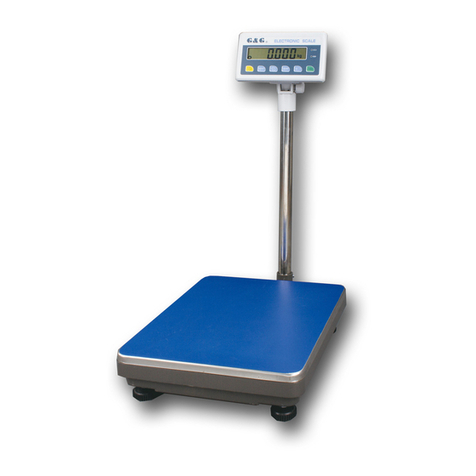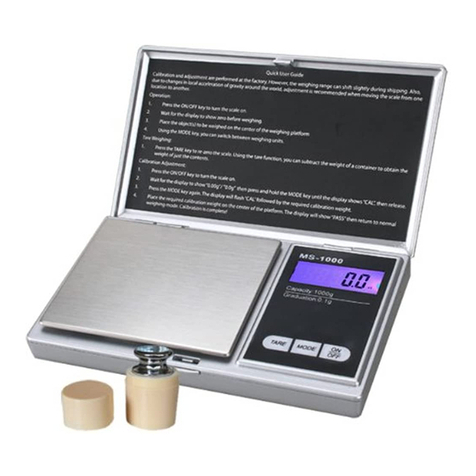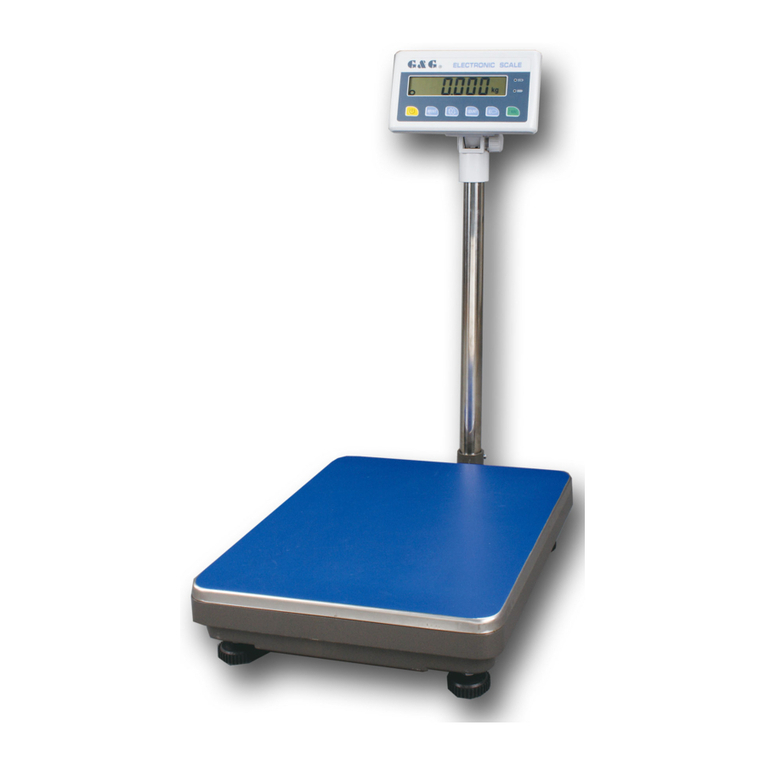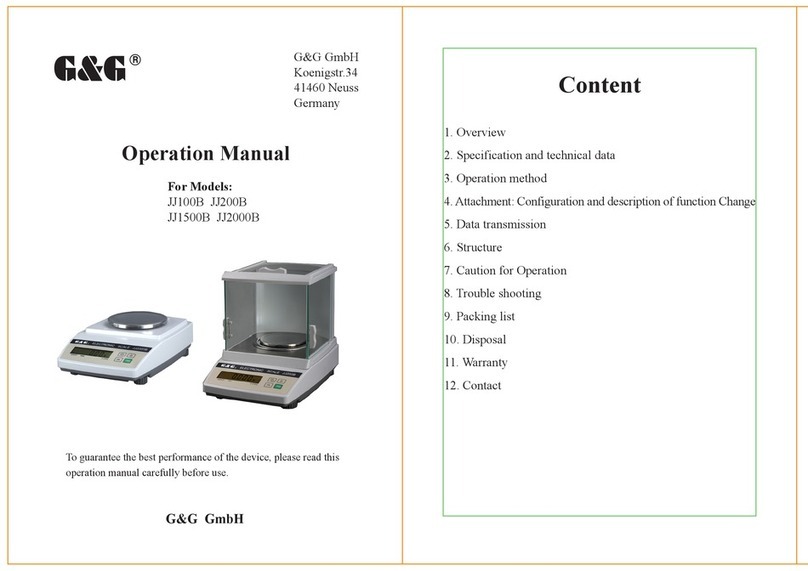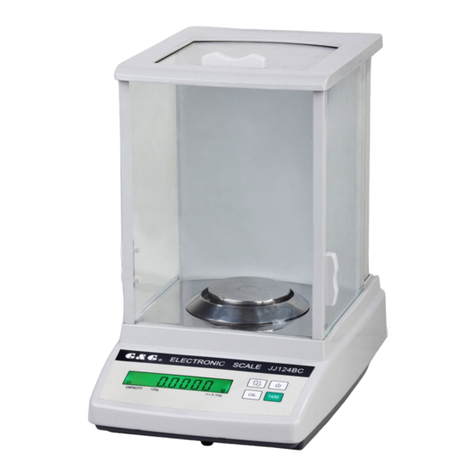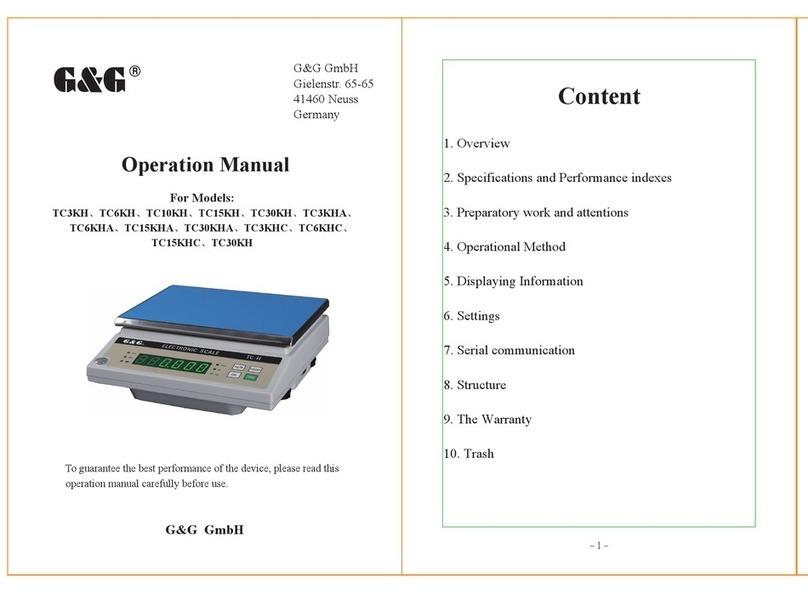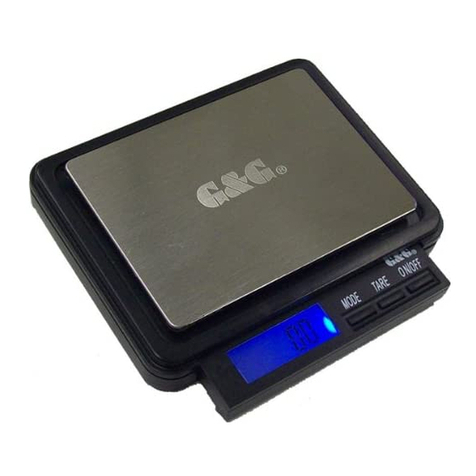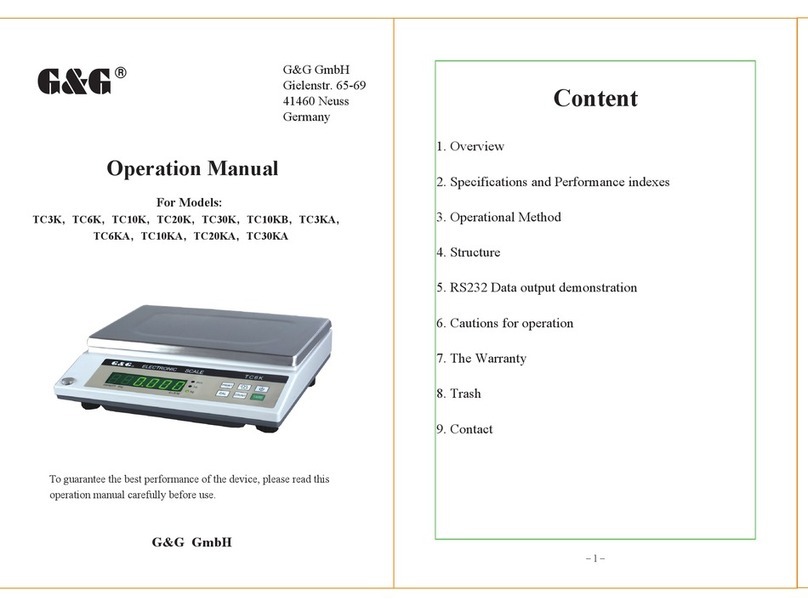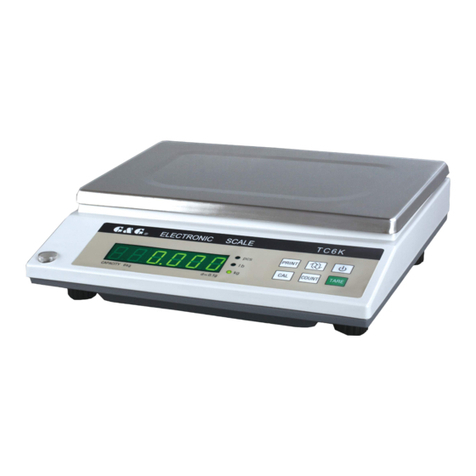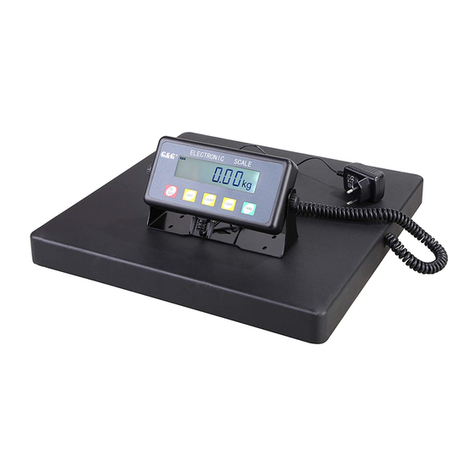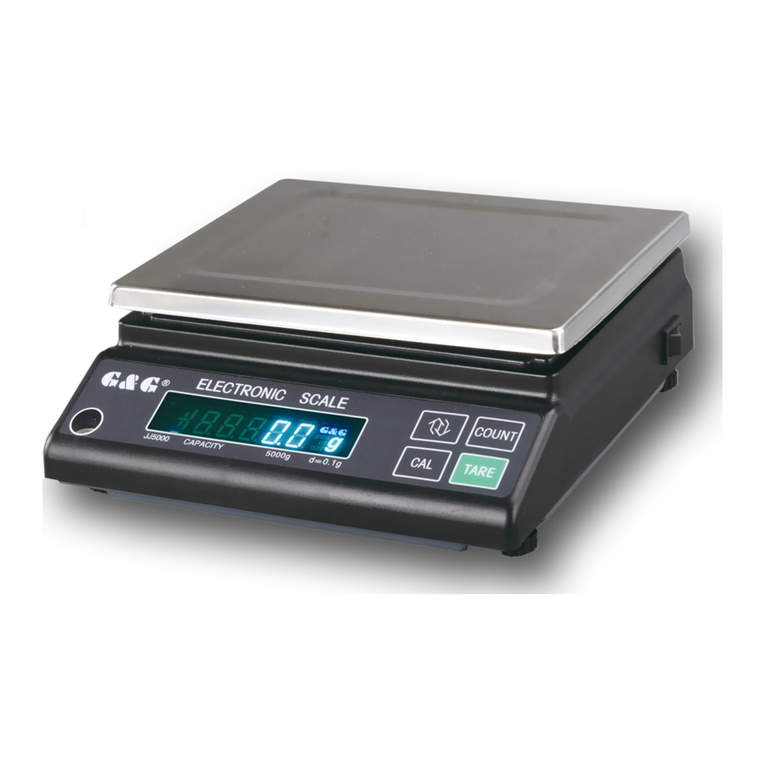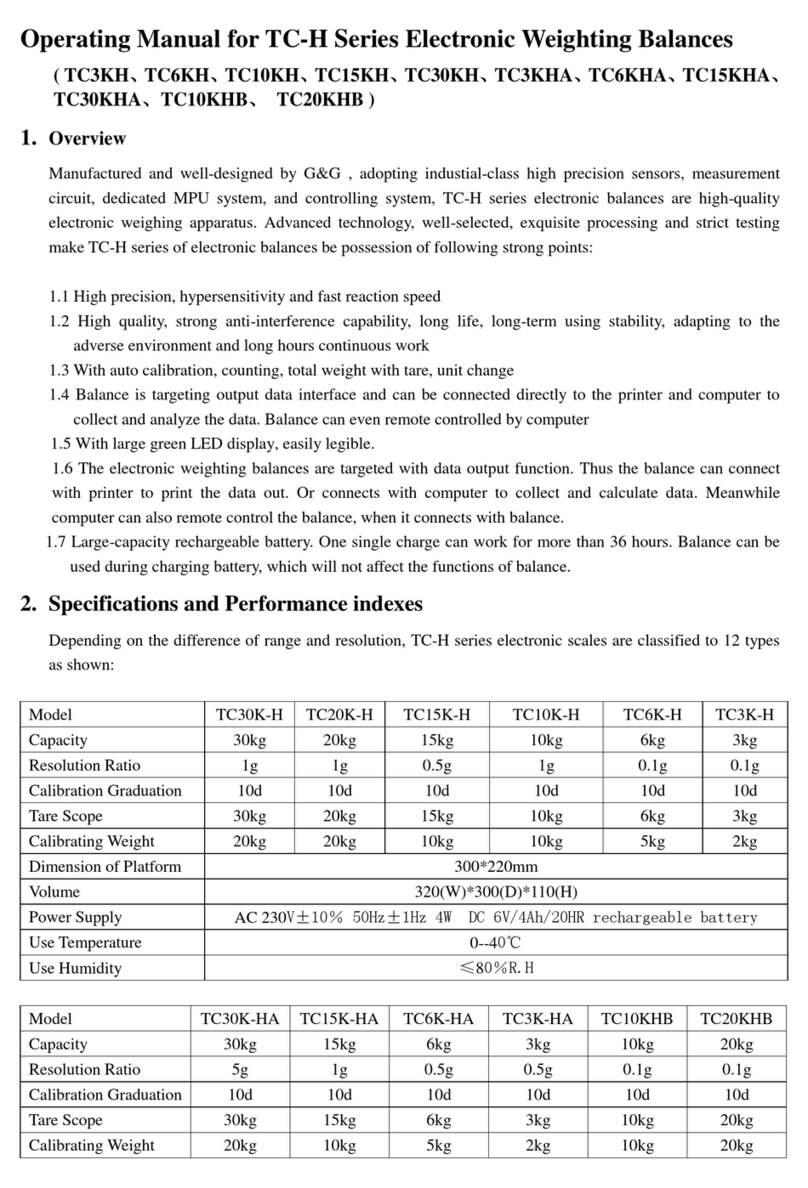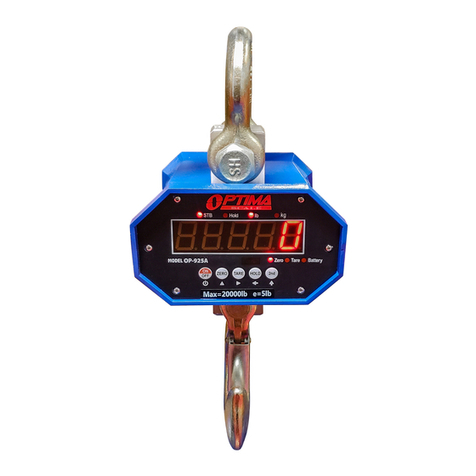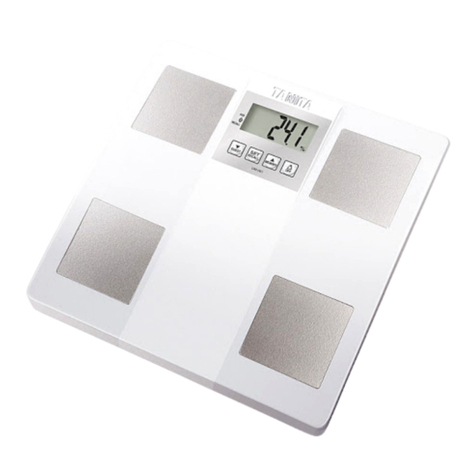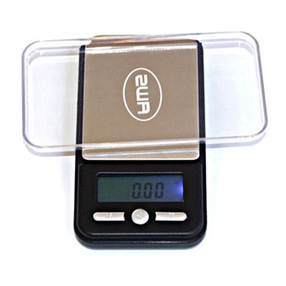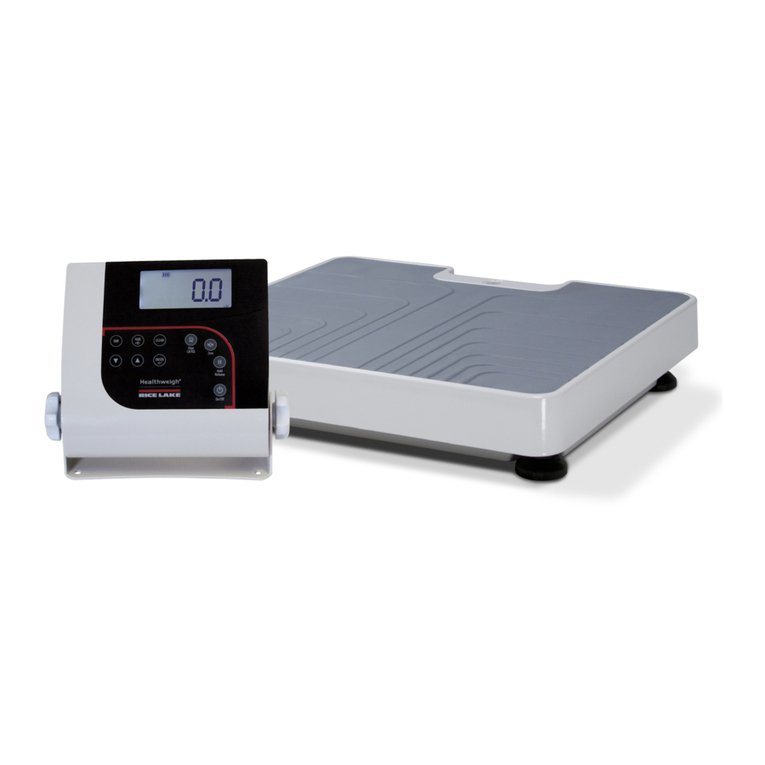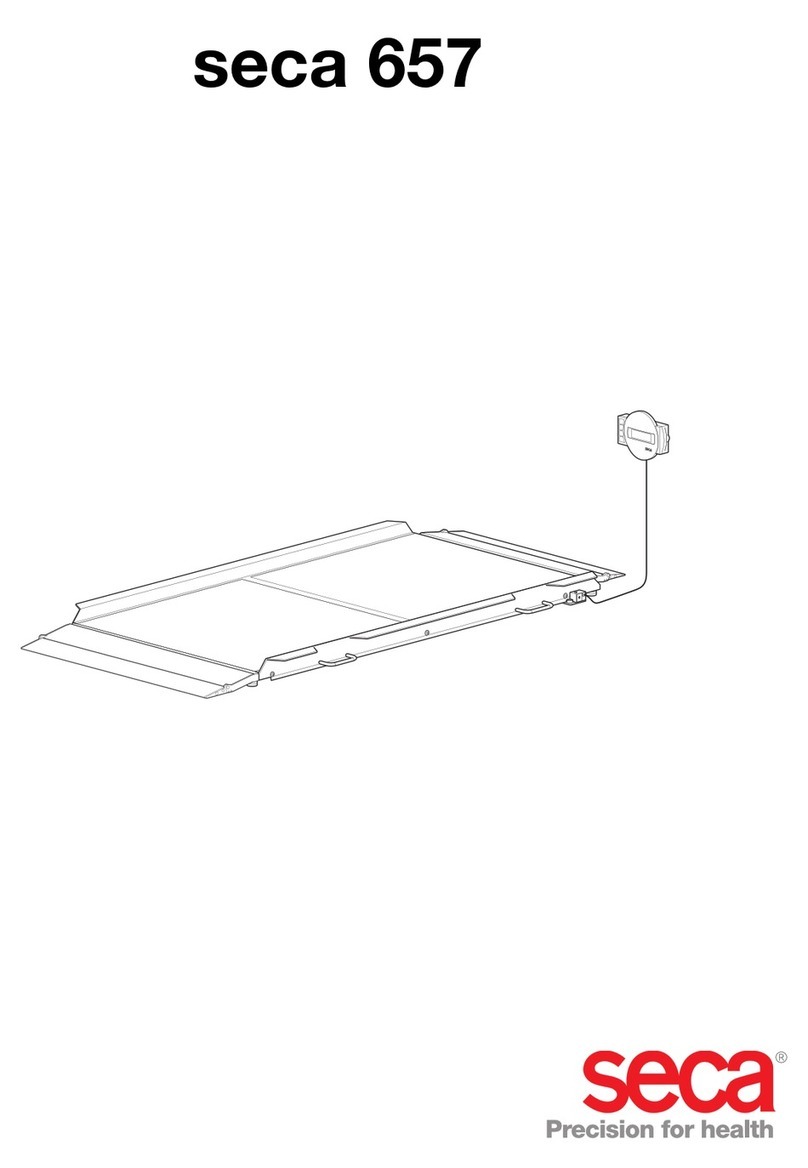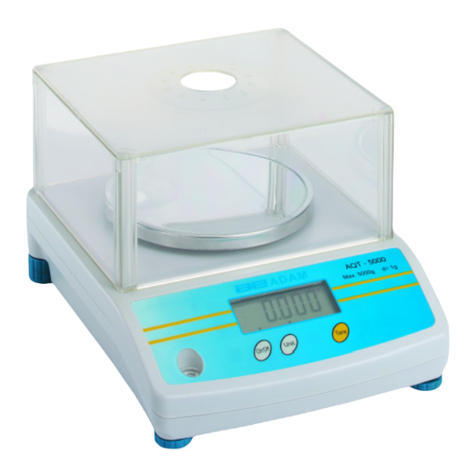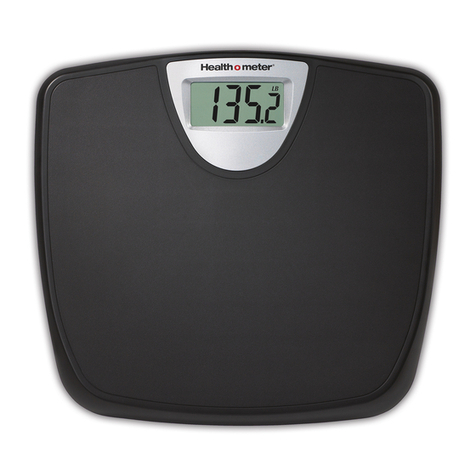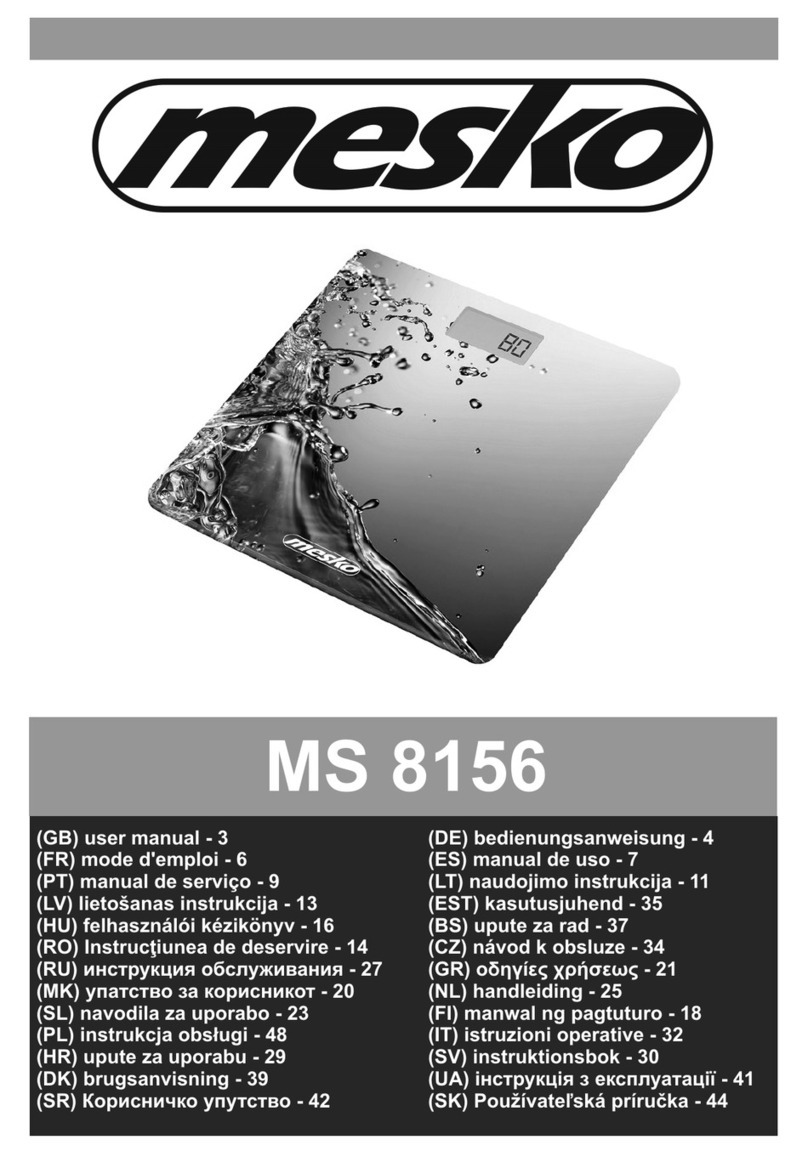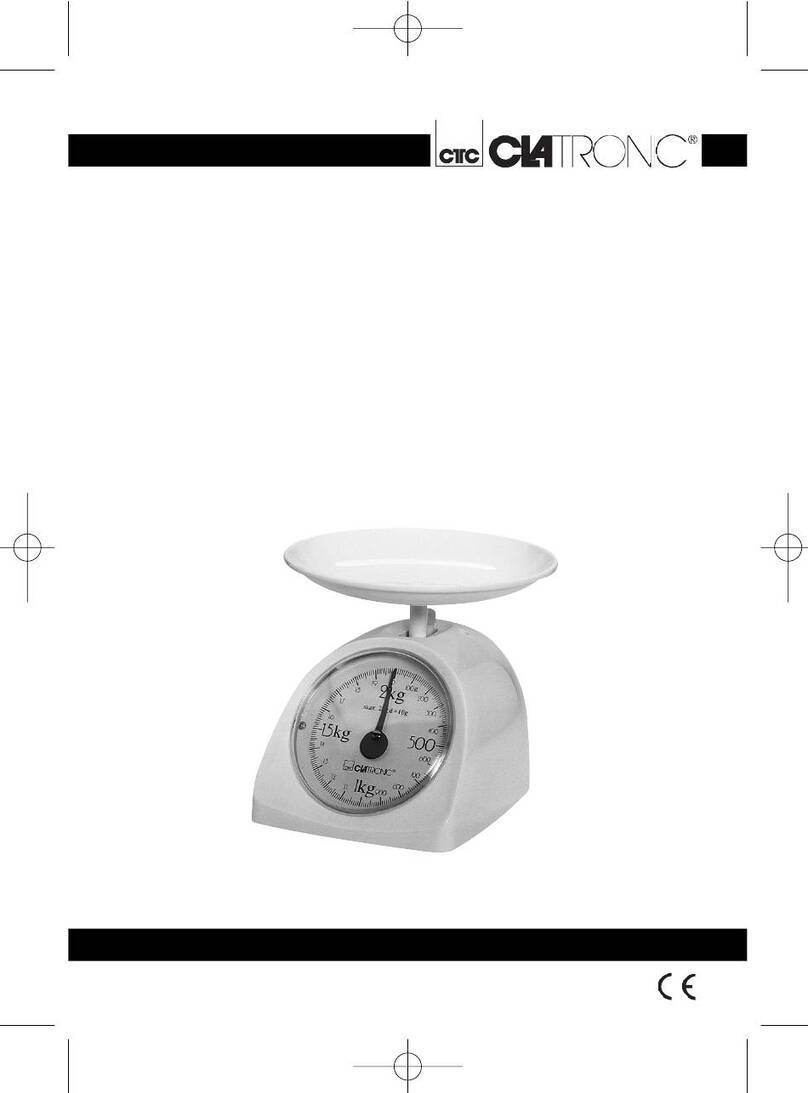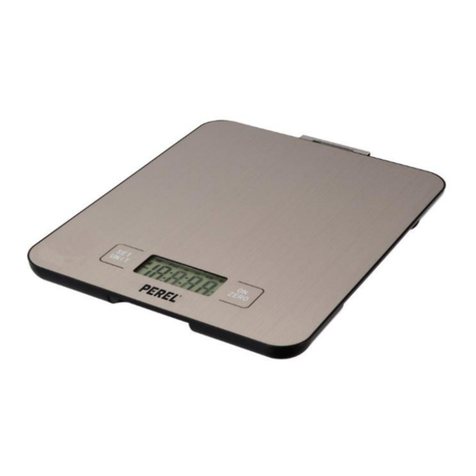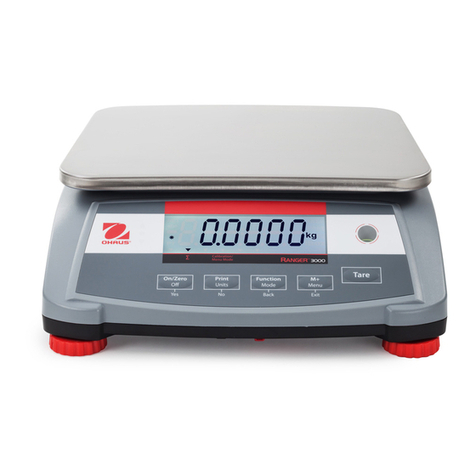G&G TJ3K Instruction Manual

Operating Instruction Manual of TJ Series Electronic counting balance
( for following models: TJ3K,TJ6K,TJ15K,TJ30K,)
1. Overview
TJ series electronic counting weighing apparatus is quality electronic weighing implement
carefully designed and manufactured by the G&G based on highly accurate sensor, measuring
circuit and special MPU system from G&G, featuring advanced technology, excellent materials,
exquisite workmanship and strict testing means, thus providing this series electronic counting
weighing apparatus with the following perfect advantages:
1.1 High accuracy and sensitivity with fast response.
1.2 Use of highly accurate strain sensor for weighing, eliminating the defect that generally,
highly accurate electromagnetic type electronic weighing apparatus can not weigh iron, nickel and
other magnetic-conductive substances.
1.3 Advanced mode of circuit and good materials and workmanship, hence the high reliability
of products, good resistance to interference, long service life, good stability in long service, and
adaptability to poor operating environment and continuous long-term operation.
1.4 Functions of automatic calibration, automatic zero tracing, counting, accumulation, tare
and pre-tare, unit conversion, preset quantity alarm and more.
1.5 Use of green LED display allowing distinct display and visible readings.
1.6 The electronic counting weighing apparatus allows options of data output interface and
printing button, direct connection with printer for data printing and even direct interface with
computer for data acquisition and statistics while the computer controls the operation of the
electronic counting weighing apparatus via the interface and conducts real-time remote control of
the electronic weighing apparatus.
1.7 Rechargeable battery with large capacity which operates continuously for over 36 hours
after one charge, and allows the use of the electronic weighing apparatus during charge, which
does not affect the behavior in service of the weighing apparatus.
2. Specification and performance indices
Depending on the difference of range and resolutions, TJ series electronic counting weighing
apparatus is classified into 4 types as shown in the table:
Models TJ30K TJ15K TJ6K TJ3K
Capacity 30kg 15kg 6kg 3kg
Resolution Ratio 1g 0.5g 0.2g 0.1g
Calibration graduation 10d 10d 10d 10d
Tare Scope 30kg 15kg 6kg 3kg
Calibrating Weight 20kg 10kg 5kg 2kg
Min. weighing 20g 10g 4g 2g
Min. sampling value 20g 10g 4g 2g
Min. unit weight value 0.5g 0.25g 0.1g 0.05g
Dimension of Platform 300*220mm
Volume 320(W)*300(D)*110(H)
Power supply AC 110V±10%50Hz±1Hz 4W DC 6V/4Ah/20HR rechargeable battery
Operating temperature 0--40℃
Operating humidity ≤80%R.H

3. Operating method
3.1 Prior to the use of the electronic weighing apparatus that has been just purchased or
laid idle for long time, power should be switched on for battery charging and leveling.
Tune-on the power switch and the weight display window displays “F----1” to
“F----9” and then “0” after holding for a period of time. Prior to the use, switch on the
power for 15 minutes of warming-up.
3.2 Tare
3.2.1 If the weight display deviates from the zero with nothing on the weighing
platform, press the “TARE” key to reset the weight display to zero.
3.2.2 If the weight of the article for which the packaging is to be removed is
unknown, place the packaging container on the weighing platform, wait till the
weight display is stable before pressing the “TARE” key. The zero is displayed
for the weight. Then place the article to be weighed in the container. Now, the
weight window displays the net weight of the article. When the article and its
container are removed, the weight display window displays the negative value
of the weight of the container. Nevertheless, press the “TARE” key so that zero
is displayed for the weight.
3.2.3 If the weight of the article for which the packaging is to be removed is known
(pre-tare), key-in the weight (in g) of the container by means of number keys,
then press the “TARE” key and the weight display window displays the net
weight of the article excluding the weight of the container. Remove the article
and container, the display window displays the negative value of the weight of
the container. Nevertheless, press the “TARE” key and the Packaging Removal
function is canceled and zero is displayed for the weight.
3.3 Calibration
When laid idle for long time or just purchased, the electronic weighing apparatus
should be subject to calibration. With nothing on the weighing platform, fully warm
up the electronic weighing apparatus (for 15 minutes or more) ,press and hold the
“CE” key followed by pressing the “UNIT W.T.” key and the weight display window
displays “C--XXX”. The unit weight display window displays “-CAL-” and it is in the
calibration state (XXX refers to the weight of the calibration required. For instance,
“10.000” means that standard weight of 10kg is desired.). Now, simply place the
calibration weight on the weighing platform, wait till stability is achieved and the
weight display window of the electronic counting weighing apparatus displays the
value of the weight. The indicator for the sign “kg” of stable weight lights, the unit
weight display window displays “0” and thus ends the calibration. Now, normal
weighing and counting is possible. Or when the unit weight display window displays
“-CAL-”, use the number keys to enter the weight value before calibration by placing
sufficient counter poise (the entered value of the weight should be between 1/3 of the
range and full range). In the calibration state, press the “TARE” key and you will
come out of the calibration state. When the weight display window displays “C----F”
during the calibration, it means that the zero is unstable. You may press the “TARE”
key for the weight display to reset before the calibration.

3.4 Counting
3.4.1 When the unit weight of the article to be weighed is unknown, place the article to be
sampled on the weighing platform, key-in the quantity of the article to be sampled,
press the “SMPL” key and the unit weight display window displays the unit weight of
the article to be sampled, the quantity display window displays the quantity of the
article to be sampled, thus ends the sampling and it is in the counting state. The larger
the quantity of the article to be sampled, the more accurate the calculated unit weight
value is.
3.4.2 When the unit weight of the article to be weighed is known, key-in the unit weight
value of the article to be weighed, then press the “UNIT W.T.” key, (If no key is
pressed for entering after 5s when numbers are keyed in, the entered number in the
unit weight window is deemed as the unit weight value of the article to be weighed.)
and thus ends the setting and it is in the counting state.
3.5 Weight Accumulation
Press the “M+” key to enter the accumulation state and the accumulation indicator lights.
The max. number of operations for accumulation is 99 and the max. number to be displayed
in the quantity display window is 99999. When weight data display is stable in the weight
display window, press the “M+” key and the weight display window displays the total
weight with the unit weight window displaying the accumulated number of operations and
the quantity display window displaying the total weight. After about 5s, you are again in the
counting state where the weight display window displays the current weight, the unit weight
window displays the unit weight and the quantity display window displays the current
quantity. When the weight display window displays zero, press the “M+” key and you will
view again the accumulated value. Press the “MC” key and you can clear the accumulated
value and are out of the accumulation state.
3.6 Presetting of quantity
For counting, the upper limit can be preset. For each of the subsequent counting, alarm is
actuated when this limit is exceeded and “--H--” flickers in the unit weight display window.
Key-in the upper limit of number to be set, press the “QTY PST” key and thus ends the
presetting of the quantity. When you press the “QTY PST” key without data entered, the
quantity display window displays the current value of preset quantity. To clear the upper
limit of preset quantity, press the “PST CE” key
3.7 Unit conversion
Press “kg/lb” key and the displayed value for weight display window switches between “kg”
(kilogram)
and “lb”
(pound)
and the indicator for relevant unit lights. The unit conversion
in the weight window does not affect the unit in the unit weight window (which is always in
g).
3.8 Data output
For the electronic weighing apparatus, standard RS232 data output interface may be used,
which may be directly connected to printer. When you are not in the number input state, press
“.” key to print counting data. Also, it may be directly connected to the computer interface.

4. Illustration of keys
0-9 Keys for entering numbers
.In the number-entering state, it is a key for decimal. When not in the number-entering state, it is
the printing key.
CE In the number-entering state, it clears the entered numbers.
When it is not in the number-entering state, press and hold the “CE” key followed by
pressing the “UNIT W.T.” key and you are in the calibration mode.
TARE In the number-entering state, press the “TARE” key, packaging pre-removal is provided for
the current entered value.
When it is not in the number-entering state, pressing the “TARE” key clears the current
weight.
In the calibration state, press the “TARE” key and you are out of the calibration state.
kg/lb The unit in the weight window between kg(or g) and lb.
UNIT
W.T.
In the number-entering state, press the “UNIT W.T.” key and the current entry is set as unit
weight.
SMPL In the number-entering state, press the “SMPI” key and the current entry is set as number of
pieces.
To set the number of pieces, the displayed data in the weight field must be more than 0.
Otherwise the set number of pieces is 0.
M+ When the displayed data in the weight field is more than 0, accumulated weight value and
value for number of pieces are re-established after the unit weight window displays the
accumulated number of operations for 5s, and the next accumulation is possible only when
the weight returns to 0.
MC Allowing you to get out of the accumulation state and clear the accumulated value.
QTY
PST
In the number-entering state, press the “QTY PST” key to set the current entry as the upper
limit of the quantity.
When it is not in the number-entering state, the quantity window displays the preset quantity
and returns after 5s.
5. Information displayed on the counting weighing apparatus
5.1The weight field displays
F----1 Data exceeds the range of display.
F----2 Error in A/D conversion circuit
F----3 Indicating that keys are available
F----5 Indicating fault in the sensor
F----L Zero of sensor signal is too low
F----H Weight exceeds the range
C----F Error in calibration. It is not at zero or the data are not stable during the calibration.
C----H Error in calibration. Article is placed on the weighing platform or the zero of the sensor
is too high during the calibration.
E----- Error in storing the calibration data. Service is possible only after re-calibration.
5.2 The unit weight field displays the following information:
-CAL- You are in the calibration state
≡ X≡ The displayed value is the number of operations for accumulation. The weight field

displays the total weight and the number-of-pieces field the total weight.
H Meaning the preset quantity is exceeded and an audible warning is given.
5.3The quantity field displays the following information:
F---1 The value of the number-of-pieces exceeds the range of display
5.4 Indicators
kg(g)Lights when the data are stable. The current weight unit is in kg(g)
lb Lights when the data are stable. The current weight unit is in lb.
SAMP↑ Lights when the total sampling amount is less than the min. sampling value.
Now, add the number of samples till the indicator is out. Set by re-sampling to
ensure the accuracy.
UNIT↑ Lights when the average or set unit weight is less than the min. unit weight
value. Now, the counting weighing apparatus remains serviceable but error may
happen during the counting. It is recommended that counting weighing
apparatus with high distinguishability is used.
Under-voltage Lights when the voltage of the battery is insufficient along with audible alarm,
charge the battery. Otherwise, the battery operates only 1-2 hours. The counting
weighing apparatus operates normally during the charge.
Charging Lights when the counting weighing apparatus is in the charging state. It takes
about 8 hours for one charge.
Fully charged Slowly lights when the counting weighing apparatus is under charge. When the
charging lamp dies out, it indicates that it is fully charged. Now, it allows further
charging.
6.Setting of adjustable parameters
Start the unit by holding down the “QTY PST” key till it comes to “F----3” and you are in the
setting mode. Press the “QTY PST” key to change the parameters to be set and press the
“TARE” key to change the parameter value.
C1---- for setting the sensitivity at 0 1 2 3 4. The higher the value and the poorer the
sensitivity, the better the stability is. The factory setting is 2.
C2---- for setting the filtering intensity at 0 1 2 3. The higher the value and the slower the
response speed, the better the stability is. The factory setting is 1 or 0.
C3---- for setting the baud rate at 2(600) 3(1200) 4(2400) 5(4800) 6(9600). The factory
setting is 6.
C4---- for setting the communication number. The “TARE” key changes the low-value and
the “kg/lb” key changes the high-value. The data are the first data to be received during the
communication. The factory setting is 27.
Start the unit by pressing the “TARE” key and all set parameters and calibrated data return
the factory state. Before service, perform re-calibration.

7.Serial communication
7.1 Serial communication protocol: baud rate: 600-9600 can set, the default settings is 9600; data
units: 8 units; ending unit: 1 unit; no calibration unit.
7.2 Data format: 41-bit data output(ASCII code)。
WT space negative data unit enter
2 unit 1 unit 1 unit 7 unit 3 unit 1 unit
UW space data unit enter
2 unit 1 unit 6 unit 2 unit 1 unit
QT space data unit enter linefeed
2 unit 1 unit 5 unit 4 unit 1 unit 1 unit
When data is not negative, the negative unit is space, no showing data is also space.
For example: weight showing 12.345 kg, unit weight showing 12.34, pieces showing 1000 and
the output data is WT□□□12.345□kg↓UW□□12.34□g↓QT□□1000□Pcs↓←41 bits。
To display accumulation
MW□□12345.6□kg↓ 15 bits
MN□□□12□□□□↓ 12 bits
MQ□12345□Pcs↓← 14 bits
7.3 Receive order:need to receive the communication, then receive order.
When the communication setting is 27(default statue), in other words Hexadecimal system 1BH,
the orders to scale are:
1BH+70H(ACSⅡcode p): print(scale required to send date once);
1BH+71H(ACSⅡcode q): calibration;
1BH+72H(ACSⅡcode r): count;
1BH+73H(ACSⅡcode s): unit conversion;
1BH+74H(ACSⅡcode t): tare;
7.4 RS232C output pins content (DB9 socket): 2 pins: RXD; 3 pins: TXD; 5pins: GND. With
computer RS232C socket (DB9 socket) connected:
2 —— 3
3 —— 2
5 —— 5
For example: when setting C3---6 C4—27 (default statue), the communication program of VB is
MSComm1.Settings = "9600,n,8,1"
MSComm1.Output = Chr(&H1B) + Chr(&H70) ’send a print order
’or MSComm1.Output = Chr(27) + Chr(112)
’or MSComm1.Output =Chr(27) +"p"
Do
DoEvents
Loop Unti MSComm1.InBufferCount = 41
a = MSComm1.Input
Print a

8. Structure
(1) Scale pan
(2) Indicator
(3) Level indicate
(4) Level adjust
(5) Function keys
(6) Numbers
9. Cautions for operation
10.1 The electronic scale is a precision instrument which is to be gently handled during the
weighing of articles. Avoid impact and heavy load on top (never exceed its max. weighing
limit).
10.2 Place the scale on a firm table for operation, and make sure that the operating
environment of the balance is free of great vibration and interference of power supply,
and of corrosive gases and liquids.
10.3 Ensure the warm-up time after power-on.
10.4 When the under-voltage indicator lights, it means the battery needs charging. No charge at
the moment may lead to inaccuracy or instability in weighing.
10. The Warranty
11.1 We provide warranty within the scope of the statutory regulations, however we are entitled to either
repair or replace the defective product.
11.2 Within one year after purchase, the producer offers a free repair service to all G & G
Product, which become defect under proper usage without human damage. The customers are
kindly requested to mail the product as well as its original proof of purchase to the producer.
Notification of defects and complaints shall be made in writing after the delivery has been received at the
point of delivery. For legitimate notifications of defects and warranty cases we are entitled at our own
discretion to either replace the delivery at the prices which were valid at the time of the complaint or to
rectify the defect.
11.3 We have the right to try to replace the defective product at least twice. There will be a slight
charge for the repair service of those products, by which the warranty period expires. Defective
goods may only be returned to us by the customer with our express approval and at the customer's cost and
risk. The notification of the defect does not release the customer from his obligation to pay.
11.4 Please attach the address, postal code and telephone number of the buyer, so that we can
mail the repaired product back in time.
11. Trash

Meaning of crossed –out wheeled dustbin:
Do not dispose of electrical appliances as unsorted municipal waste, use separate collection
facilities.
Contact you local government for information regarding the collection systems available.
If electrical appliances are disposed of in landfills or dumps, hazardous substances can leak into
the groundwater and get into the food chain, damaging your health and well-being.
When replacing old appliances with new ones, the retailer is legally obligated to take back your
old appliance for disposals at least free of charge.
12. Contact
G&G MEASUREMENT PLANT
ADD:xushitown,changshu,jiangsu
TEL:0512-52671954
FAX:0512-52671339
http://www.gandg.com.cn
This manual suits for next models
4
Table of contents
Other G&G Scale manuals
